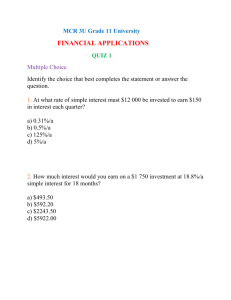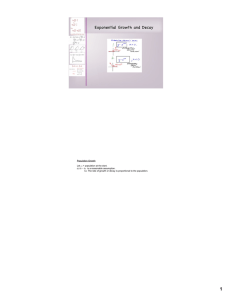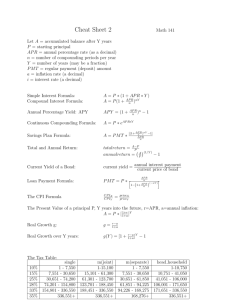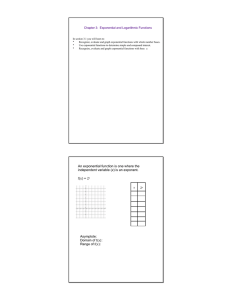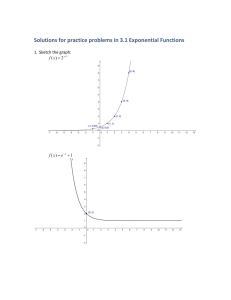Honors 2201-4 Fall 2003 Homework 6 Solutions Section 2.5
advertisement
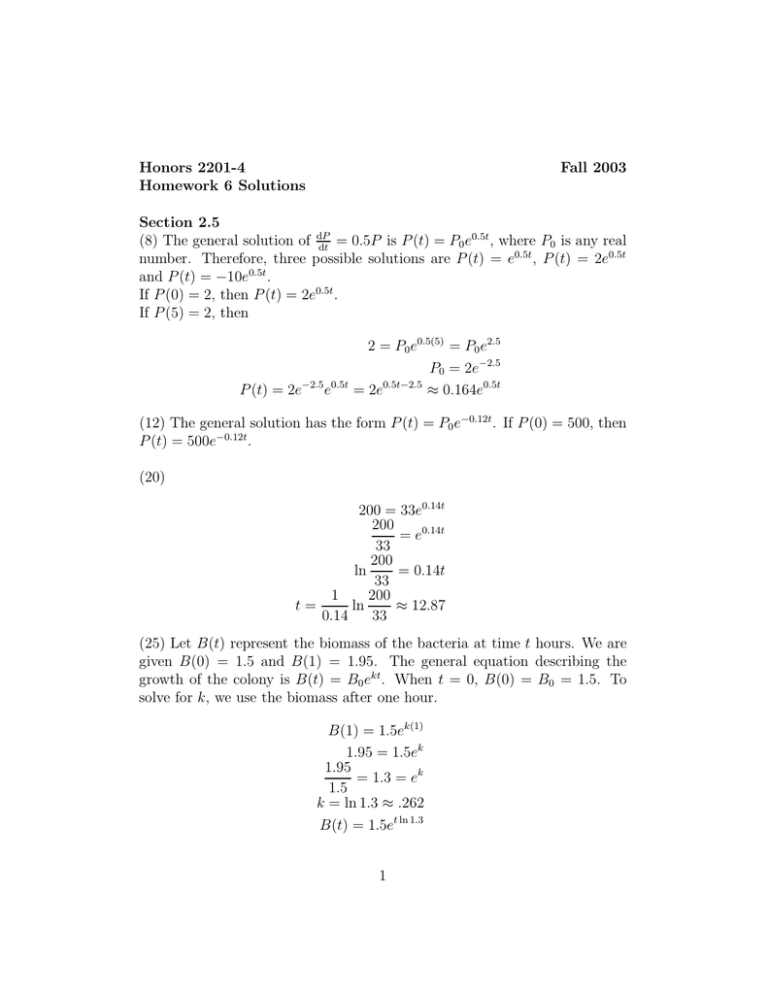
Honors 2201-4 Homework 6 Solutions Fall 2003 Section 2.5 (8) The general solution of dP = 0.5P is P (t) = P0 e0.5t , where P0 is any real dt number. Therefore, three possible solutions are P (t) = e0.5t , P (t) = 2e0.5t and P (t) = −10e0.5t . If P (0) = 2, then P (t) = 2e0.5t . If P (5) = 2, then P (t) = 2e−2.5 e0.5t 2 = P0 e0.5(5) = P0 e2.5 P0 = 2e−2.5 = 2e0.5t−2.5 ≈ 0.164e0.5t (12) The general solution has the form P (t) = P0 e−0.12t . If P (0) = 500, then P (t) = 500e−0.12t . (20) 200 = 33e0.14t 200 = e0.14t 33 200 ln = 0.14t 33 200 1 ln ≈ 12.87 t= 0.14 33 (25) Let B(t) represent the biomass of the bacteria at time t hours. We are given B(0) = 1.5 and B(1) = 1.95. The general equation describing the growth of the colony is B(t) = B0 ekt . When t = 0, B(0) = B0 = 1.5. To solve for k, we use the biomass after one hour. B(1) = 1.5ek(1) 1.95 = 1.5ek 1.95 = 1.3 = ek 1.5 k = ln 1.3 ≈ .262 B(t) = 1.5et ln 1.3 1 The measurement made at 4:30 was 8 hours after the first measurement, so B(8) = 1.5e8 ln 1.3 ≈ 12.24 biomass units of bacteria. (26) Let M(t) be the concentration of methane at year t. Assume that the effective increase over one year is one percent. Therefore, M1 = 1.01M0 . The general form for the methane concentration equation is M(t) = M0 ekt . Thus, M(1) = 1.01M0 = M0 ek 1.01 = ek k = ln 1.01 Let t∗ be the time it takes for the methane concentration to increase by fifty percent. Then, M(t∗ ) = 1.5M0 = M0 et ln 1.01 ∗ 1.5 = et ln 1.01 ln 1.5 = t∗ ln 1.01 ln 1.5 t∗ = ≈ 40.75 ln 1.01 ∗ It only takes 40.75 years for the methane to increase by fifty percent. In the following problems, let M(t) represent the amount of money in your bank account after t years. Also assume that M(0) = M0 = 1000.00 is the initial amount of money deposited. (27) If interest is compounded annually, the general form for M(t) is M(t) = M0 (1 + .08)t . Since M0 = 1000.00, M(t) = 1000.00(1.08)t. M(1) = 1080.00, M(2) = 1166.40, and M(20) = 4660.96. (28) If interest is compounded quarterly, the general form for M(t) is M(t) = 1000.00(1 + .08/4)4t = 1000.00(1.02)4t. M(1) = 1082.43, M(2) = 1171.66, and M(20) = 4875.44. If interest is compounded monthly, the general form for M(t) is M(t) = 1000.00(1 + .08/12)12t = 1000.00(1 + 1/150)12t . M(1) = 1083.00, M(2) = 1172.89, and M(20) = 4926.80. 2 If interest is compounded daily, the general form for M(t) is M(t) = 1000.00(1+ .08/365)365t . M(1) = 1083.28, M(2) = 1173.49, and M(20) = 4952.16. Looking at the above results, we see that the annual compounding has an effective yield of 8%, quarterly compounding has an effective yield of 8.243%, monthly compounding has an effective yield of 8.300%, and daily compounding has an effective yield of 8.328%. (29) If interest is compounded continuously, we know that dM = .08M dt Therefore, the general form for M(t) is M(t) = 1000.00e.08t . M(1) = 1083.29, M(2) = 1173.51, and M(20) = 4953.03. The effective yield in this case is 8.329%. Continuous compounding has an effective yield that is .001% larger than daily compounding. (30) If we set k = 0.08 and let ∆t represent the time (in years) between compoundings, then (1+k∆t)1/∆t is the factor by which your initial deposit is magnified after one year. As the time between compoundings decreases ∆t → 0, we approach continuous compounding. In the continuous compounding case, the factor by which your initial deposit is magnified after one year is ek . (31) Let M0 be the initial deposit. We will calculate the effective yield for each of the three banks. The general equation for money earned at First National is M(t) = M0 (1 + .0825/365)365t . Therefore, M1 = 1.0860M0 indicating an effective yield of 8.60%. The general equation for money earned at Merchants and Farmers is M(t) = M0 (1 + .08375/4)4t. Therefore, M1 = 1.0864M0 indicating an effective yield of 8.64%. The general equation for money earned at Central Savings and Loan is M(t) = M0 (1 + .0850)t . Therefore, M1 = 1.0850M0 indicating an effective yield of 8.50%. 3 The effective yield for the Merchants and Farmers Bank is the highest (8.64%), so if you are planning to deposit money in a long-term savings account, it should be deposited here. However, if you are planning to withdraw some of your money in less than three months, it would be wise to invest at the First National Bank as well. At First National, interest is compounded daily, so money deposited on the first day of the month will already be worth more on the second day. At Merchants and Farmers, if you withdraw money after 2 months and 29 days, it will have the same value as when you first deposited it. (32) Let td represent the doubling time in years. M(td ) = 2M0 = M0 etd (r/100) td (r/100) 2 = e r ln 2 = td 100 69.31 100 ln 2 ≈ td = r r r 2 4 8 12 18 td 69 72 34.66 34.5 36 17.33 17.25 18 8.664 8.625 9 5.776 5.75 6 3.851 3.833 4 The rule of 69 comes closest to the real answers. This makes sense as the exact rule divides 100 ln 2 ≈ 69.31 by r. People in business might prefer the rule of 72 since it is more conservative. It’s better to expect less than you have than to have less than you expect. Also, 72 is a multiple of 2, 3, 4, 8 and 12 so it is easier to work with. 4


